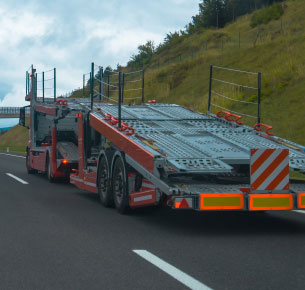Snow removal and winter travel
Regardless of the weather conditions, drivers are required to reduce speed and–if conditions become too dangerous–drivers must stop and wait until the vehicle can be operated safely again.
When it comes to driving through snow, drivers should be aware that vehicles must be fully clear of ice and snow before winter travel. If snow or ice falls from a moving vehicle and strikes another vehicle or pedestrian causing death or serious bodily injury, the operator of that vehicle could receive a $200 to $1,000+ fine.
In most states, drivers must make “reasonable efforts” to remove snow or ice from all parts of their vehicles within 24 hours of a weather event.
In Pennsylvania, truck operators would be excused if they are on their way to a facility to remove accumulated snow or ice. In addition, violations would not be issued if compliance would cause the trucker to violate any federal or state law or regulation regarding workplace safety, or if it would be a health or safety threat.
State Chain Laws
When driving through snow, drivers need to make sure tire chains are safely secured and ready to be used when required by state rules.
Of course, there are fines associated with violating these rules.
For example, in Colorado the fine for not carrying chains on I-70 between mileposts 133 and 259 from September 1 to May 31 is $50 plus a $17 surcharge. Statewide, the fine for not chaining up when the chain law is in effect is $500 plus a $79 surcharge. The fine for not chaining up and subsequently blocking the highway is $1,000 plus a $157 surcharge.
Each state has their own requirements for carrying chains on commercial motor vehicles, or CMVs that are:
- Medium duty: vehicles with a gross vehicle weight (GVW) rating of more than 10,000 pounds to 26,000 pounds such as buses, recreational vehicles, and cargo vehicles
- Solo commercial: vehicles with a GVW rating of 26,001+ pounds not towing
- Commercial vehicles with trailers: vehicles with a GVW rating of 26,001+ pounds towing one or more trailers
Below is a quick summary of state snow chain requirements:
- Alabama:Tire chains or snow tires may be used by any vehicle when required for safety due to snow, rain, or other slippery conditions
- Arizona: Tire chains or snow tires may be used by any vehicle when required for safety due to snow, rain, or other slippery conditions
- California: No specific dates for chains, but signs will be posted when chains are required
- Colorado: Commercial vehicles traveling on certain roads must carry chains from September 1 May 31
- Connecticut: Studded tires and non-skid devices may be used from November 15 – April 30
- Delaware: Tire chains or snow tires may be used by any vehicle when required for safety due to snow, rain, or other slippery conditions
- Florida: no tire chain laws
- Georgia: Tire chains or snow tires may be used by any vehicle when required for safety due to snow, rain, or other slippery conditions
- Hawaii: no tire chain laws
- Idaho: No specific restrictions, it is advised to avoid it unless necessary
- Iowa: Tire chains or snow tires may be used by any vehicle when required for safety due to snow, rain, or other slippery conditions
- Illinois: Tire chains or snow tires may be used by any vehicle when required for safety due to snow, rain, or other slippery conditions
- Indiana: Tire chains or snow tires may be used by any vehicle when required for safety due to snow, rain, or other slippery conditions
- Kansas: Tire chains or snow tires may be used by any vehicle when required for safety due to snow, rain, or other slippery conditions
- Kentucky: May not be used unless road is ice-covered or vehicle has an ice shoe at least 6 in wide. Limit on diameter and spacing
- Louisiana: Tire chains or snow tires may be used by any vehicle when required for safety due to snow, rain, or other slippery conditions
- Maine: Tire chains or snow tires may be used by any vehicle when required for safety due to snow, rain, or other slippery conditions
- Massachusetts: Permitted from November 1 – May 1
- Maryland: Required when snow emergency has been declared, not allowed on vehicles weighing more than 10,000 lbs
- Michigan: Tire chains or snow tires may be used by any vehicle when required for safety due to snow, rain, or other slippery conditions
- Minnesota: Permitted when road conditions call for it. Studded pneumatic tires not allowed on state registered vehicles
- Mississippi: Tire chains or snow tires may be used by any vehicle when required for safety due to snow, rain, or other slippery conditions
- Missouri: no tire chain laws
- Montana: Permitted October 1 – May 1, not mandatory unless notices are posted. Specific regulations for studded tires
- Nebraska: Metal studs only permitted November 1 – April 1. School buses, mail carrier vehicles, and emergency vehicles are permitted year-round
- Nevada: Required on all vehicles over 10,000 lbs when requirements in effect. Studded tires permitted between October 1 – April 30
- New Hampshire: no tire chain laws
- New Jersey: Tire chains or snow tires may be used by any vehicle when required for safety due to snow, rain, or other slippery conditions
- New Mexico: Tire chains or snow tires may be used by any vehicle when required for safety due to snow, rain, or other slippery conditions
- New York: Required when a snow emergency has been declared
- North Carolina: Tire chains or snow tires may be used by any vehicle when required for safety due to snow, rain, or other slippery conditions
- North Dakota: Tire chains or snow tires may be used by any vehicle when required for safety due to snow, rain, or other slippery conditions
- Ohio: Only permitted between November 1 – April 1, except for public safety or school bus.
- Oklahoma: Tire chains or snow tires may be used by any vehicle when required for safety due to snow, rain, or other slippery conditions
- Oregon: Required on vehicles over 10,000 lbs when SNOW ZONE signs are posted
- Pennsylvania: Permitted between November 1 – April 15, restrictions on size of tires or studs
- Rhode Island: Tire chains or snow tires may be used by any vehicle when required for safety due to snow, rain, or other slippery conditions
- South Carolina: Tire chains or snow tires may be used by any vehicle when required for safety due to snow, rain, or other slippery conditions
- South Dakota: Tire chains or snow tires may be used by any vehicle when required for safety due to snow, rain, or other slippery conditions
- Tennessee: Permitted October 1 – April 1, specific regulations on percentage of wire or other material that comes in contact with the road
- Texas: Tire chains or snow tires may be used by any vehicle when required for safety due to snow, rain, or other slippery conditions
- Utah: Between November 1 – March 31, if signs are posted, vehicles must have chains or snow tires
- Vermont: no tire chain laws
- Washington: Signs marked “chains required” will be posted. On certain routes, chains must be carried from November 1 – March 31
- Washington, D.C.: no tire chain laws
- West Virginia: Tire chains or snow tires may be used by any vehicle when required for safety due to snow, rain, or other slippery conditions
- Wisconsin: Tire chains or snow tires may be used by any vehicle when required for safety due to snow, rain, or other slippery conditions
- Wyoming: Signs will be posted indicating when chain laws are in effect, must use adequate snow tires or chains.
Anti-Idling States
Idling your vehicle in winter to warm up your vehicle sounds like a no brainer but over the past 20 years, state lawmakers have passed various legislation to minimize vehicle idling.
Generally, to trigger an investigation, anyone can report excessive idling. A local health department will initiate an investigation in response to complaints from one or more citizens regarding an illegally idling vehicle.
To verify a complaint and issue an enforcement action, investigations are usually performed, and the investigator must verify that the idling exceeds the state limit and is not allowed by one of the exceptions in the idling rule.
CDL drivers need to be aware of these laws, so you are less likely to be put in danger of large fines by an innocent mistake.
Here are the top 5 strictest anti-idling states.
0 Minute Unattended Idling:
Wyoming – Idling an unattended vehicle outside a business or residential areas is Illegal. Do not leave your vehicles idling all alone in the cold. While this covers a lot of places, it does not account for open stretches of road.
According to Wyoming Statute 31-5-509: “No person driving or in charge of a motor vehicle shall permit it to stand unattended without first stopping the engine, locking the ignition, removing the key from the ignition, effectively setting the brake thereon and, when standing upon any grade, turning the front wheels to the curb or side of the highway.”
The penalty is a misdemeanor charge and a possible $750 fine.
3-Minute Idling Limit:
Delaware – Idling of an on-road vehicle over 8,500 pounds gross vehicle weight for longer than three minutes is prohibited in Delaware with some exceptions. Violators are subject to penalties of not less than $50 and up to $500 for each offense. Subsequent violations carry fines of from $500 to $1,500.
Washington DC – Motor vehicles powered by gasoline or diesel are not allowed to idle for more than three minutes while the vehicle is parked, stopped or standing. There is an exception for truck Idling when operating a heater when it’s freezing outside that extends the time to 5 minutes.
New Jersey – New Jersey has a 3-minute idling rule with an exception for sub-freezing temperatures and another one for sleeping berths. (Reference New Jersey Administrative Code 7:27-14.3 through 7:27-14.10 and 7:27-15.8)
Note: A late-2022 bill introduced at the New Jersey statehouse would change idle time to 2 minutes, with exceptions.
First offenses for passenger vehicles can result in $100 fines and $250 for commercial vehicles. Subsequent offenses can result in fines from $200 to $1,000.
Virginia – In commercial or residential urban areas, vehicles used commercially or for public service cannot idle for longer than 3 minutes while parked, unless the propulsion engine is providing auxiliary power for other than heating or air conditioning. Tour buses and diesel-powered vehicles in the state can idle for up to 10 minutes, according to the EPA.
There are also 11 states that limit idling to 5 minutes for most vehicles, with various exceptions or limits. These include California, Maine, Maryland, Massachusetts, New Hampshire, New York, Oregon, Pennsylvania, Rhode Island, Texas, Utah, and Vermont.
Another four states limit idling time to 14 to 15 minutes. These are: Illinois, South Carolina, Nevada, and West Virginia.
Adverse driving conditions exception
In 2020, the FMCSA updated several exceptions in the Hours of Service rules, including changes to the adverse driving conditions exception.
The adverse driving exception applies to conditions that you did not know about when you started your run–like snow, fog, or a shut-down of traffic due to an accident, but excludes conditions that you should have known about, such as congested traffic during typical rush hour periods.
The exemption changed to extend both their drive-time limit and their on-duty window by 2 hours if drivers encounter adverse conditions such as weather or traffic congestion.
According to the FMCSA, the provision will allow drivers to either sit and wait out the conditions or to slowly drive through them with caution.
Drivers are also encouraged to monitor state agency social media accounts for the most up-to-date information on any emergency or weather-related situation affecting the state, in addition to any social media accounts for your local emergency management offices.







